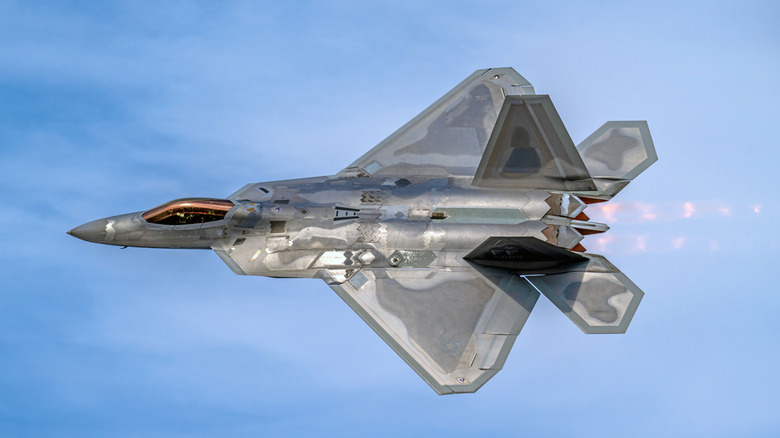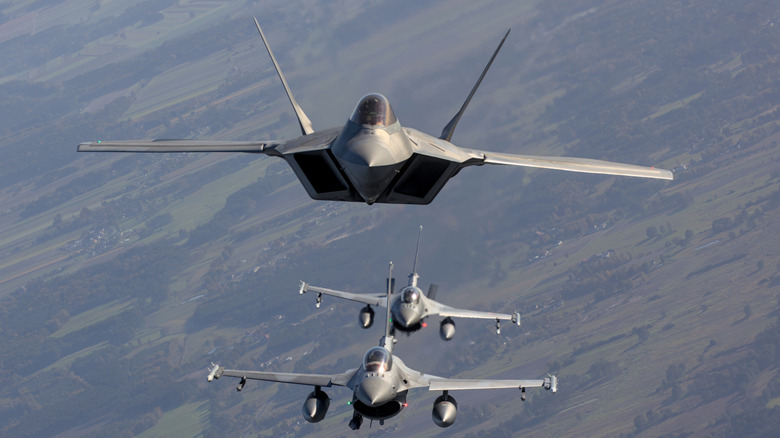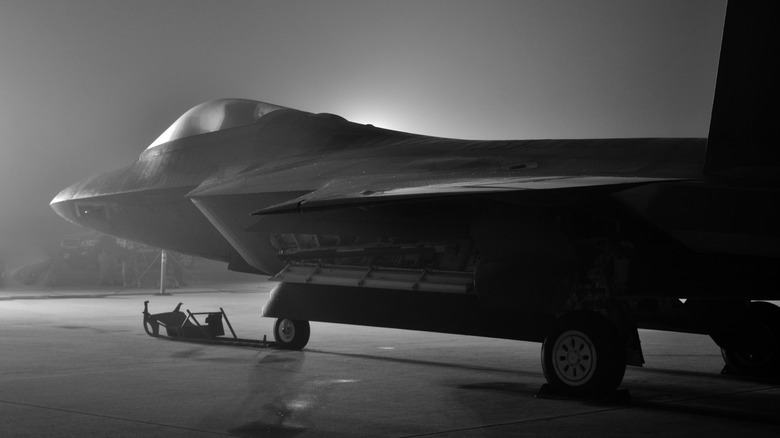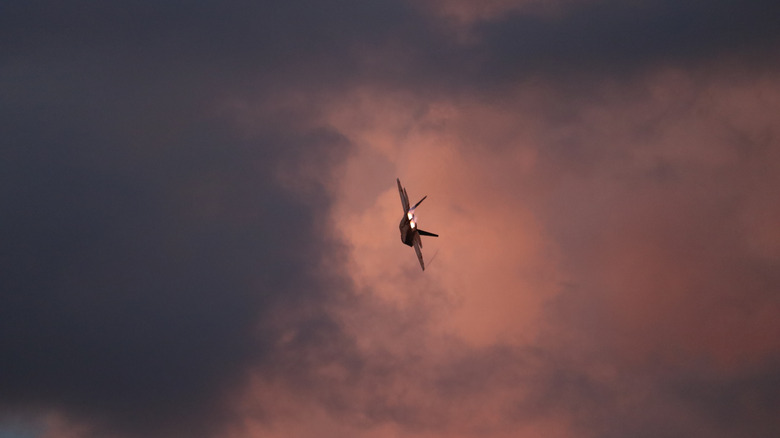Why The US Banned The F-22 Raptor From Being Exported
Jets: They're pretty cool, right? They zoom around pew-pewing, diving, dipping, and banking hard lefts or rights with Tom Cruise in the cockpit in "Top Gun: Maverick." That was a pretty solid movie, and of course the practical effects far outstrip any garbage CGI or green screen ... Hang on, sorry. We're talking about real life, not fantasyland. Real life, which is full of real, multimillion-dollar jets like the F-15, F-16, F-22, and F35A (Lightning II, no less). And in real life, real people get hurt and die, and real stakes are on the line when folks get their hands on some really high-tech, potentially devastating weaponry. That's why the United States has not, and will not, share F-22 Raptors with other nations, not even allies. Plus, they're really, really expensive anyway.
It's not that allies haven't come knocking about the F-22. Countries like Japan, Australia, and Israel have all said, "Hey, can we, uh ... have some of those?" But no. In 1998, the U.S. government voted to amend the Department of Defense Appropriations Act (H.R.2266) to specifically ban the sale of F-22s to other countries. As Congress itself says, "None of the funds made available in this Act may be used to approve or license the sale of F-22 advanced tactical fighter to any foreign government." The "funds" in question relate to budgetary spending used to buy F-22s from Lockheed Martin. And why do we not peddle them? They're just too advanced, and the U.S. would be compromising its military advantage.
F-22s are too advanced to sell
So what about F-22s makes them so gosh darn awesome that the U.S. won't sell any? Well, not to let loose secrets that would compromise the military superiority of the United States or anything, but: everything. The Air Force has a full (and fully disclosed) breakdown on these bad boys, including the monstrous price tag of $143 million per jet. Compare this to an F-15 Eagle that costs $27.9 million for A/B models and $29.9 million for C/D models. Or an F-16 Fighting Falcon that costs $14.6 million for A/B models and $18.8 million for C/D models. That's almost 10 F-16A/Bs for the price of one F-22. So, it's possible that other countries couldn't afford F-22s, anyway. Even the U.S. only had 183 of them as of 2022.
As far as fighting and flying specs are concerned, the F-22 is the elite of the elite. As the Air Force says, it's a supreme fusion of "stealth, supercruise, maneuverability, and integrated avionics, coupled with improved supportability" that "cannot be matched by any known or projected fighter aircraft" and "represents an exponential leap in warfighting." The F-22 and its weaponry supports all branches of the military across the world, and it includes GBU-32 Joint Direct Attack Munitions, which are free-fall smart bombs with GPS guidance systems. It's also got an advanced sensor suite, greater thrust than any other jet, superb mobility due to an aerodynamic design and light weight, and more. In fact, it's so advanced that it actually contains classified technology that the U.S. doesn't want anyone else having.
The high cost of F-22 development, maintenance, and upgrades
As mentioned, Lockheed Martin develops F-22s for the U.S. military. The company is America's largest defense contractor, having won a total of $61.4 billion in military contracting bids in 2023 alone. That's $61.4 billion out a total, colossal defense budget of $841.4 billion. But Lockheed Martin's ongoing relationship with its F-22s isn't limited to one "do all the stuff" bid. There are many that cover all of the F-22's development, maintenance, upgrades, etc. This breadth of operations indicates how difficult it would be for another country to use, maintain, and upgrade their own F-22s if the U.S. sold any to them.
In 2021, for instance, Defense News says that Lockheed Martin won a $10.9 billion to modernize their F-22s, which originally hit the skies back in 1997. This bid included logistics support, upgrades, and fixing existing jets. Recently, in January, 2025, Lockheed Martin won a smaller $270 million bid to incorporate cutting-edge infrared sensors into the aircraft. And just to show the reader how tangled the military production web is, a different company named Pratt & Whitney actually makes the F-22's F119 engine. Breaking Defense reports that they won a $1.5 billion contract in 2025 to keep doing so, a bid that spans over 400 power plants. So if another country got their hands on F-22s, how could it keep up with all these alterations? This is on top of the fundamental flight training needed to handle one and logistical know-how that companies like Lockheed Martin provide.
Maintaining U.S. global military dominance
Yes, F-22s are expensive and super advanced. And while it's obvious why the U.S. wouldn't sell these ultra-powerful weapons to an enemy, we mentioned that it also won't sell them to allies. That's because in the end, all of the country's defense expenditures, bids, ongoing upgrades to existing machines, etc. — they all exist to maintain U.S. military dominance across the globe. That means not only quality, but quantity.
According to Global Firepower, as of 2025, the U.S. has more military aircraft than any other nation by far at 13,043 units — including its 183 or so F-22s. That's so much more than other countries that the U.S. air fleet accounts for 53.3% of all military aircraft worldwide. Russia has the next highest number of military aircraft at 4,292, followed by China at 3,309. The top five air powers mirror overall military global power rankings, placing the United States at No. 1, followed by Russia, China, India, and South Korea. Air power is critical to modern warfare, and this helps explain why the U.S. has cultivated its fleet of aircraft.
Readers might be wondering: If we're interested in protecting ourselves from enemies, why not share the F-22 power? Well, that would require losing some power to other allied nations and making them less reliant on the U.S. as a result. It's a strong-arm strategy fraught with moral questions, yes. But it's a strategy that illustrates a hard truth: The real world isn't "Top Gun."
For further reading, check out the absolute worst fighter planes that existed during World War II.



